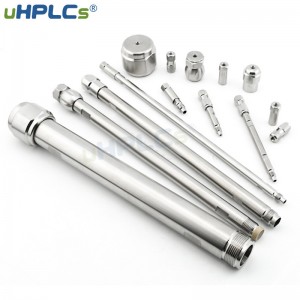1, Way to improve the HPLC Column efficiency of liquid chromatography
Improving the efficiency of liquid chromatography can start from the following aspects.
(1) reduce the flow rate of the mobile phase but will make the analysis time longer.
(2) Reduce the stationary phase amount, but the column sample loading is also reduced.
(3) Reduce the particle size of the stationary phase, but not excessively, as the permeability of the column will also be reduced.
(4) Use a low viscosity mobile phase to facilitate the rapid mass transfer, but it is not conducive to multi-component analysis.
(5) Appropriate increase in column temperature can reduce the viscosity of the mobile phase, but the column efficiency and separation are also reduced.
(6) Minimize the stagnant mobile phase’s volume but accelerate the mobile phase’s flow rate. From the above introduction, it can be seen that various factors are interrelated and constrained in the chromatographic process. Only through the tracking measurement of the HPLC column effect value and the continuous research and practice of one’s analysis method can one find the best working conditions.
2, the column effect value of tracking measurement should pay attention to the problem
We should also remember that column efficiency values cannot predict column performance under all conditions. For most chromatographer, column performance refers to the ability of a lc column to be used for a specific separation, and high column efficiency alone does not guarantee this separation.
Regardless of the particular test method used, several parameters affect the determination of column efficiency. These parameters include
The composition and viscosity of the eluate and its linear flow rate, the solute used to determine the number of plates, the temperature, the hplc column length, the packing method, the particle size, and the measurement and calculation method chosen. The measurement and calculation methods play a great role in determining the column efficiency value.

3. Several methods of measuring and calculating column efficiency values
Because the chromatographic peak is assumed that the sample concentration in the mobile phase and the stationary phase is normally distributed and the sample band distribution is obtained, the chromatographic peak shape is often regarded as a normal curve to calculate the theoretical tower plate number. Therefore, the formula for calculating the column efficiency (in terms of theoretical tower number n) is customarily defined as

where tR is the retention time of the chromatographic peak.
σ2 is the deviation of the chromatographic peak measured in units of time.
A is a constant related to the peak height (from the baseline measure of the measured peak width).
ωb is the peak width, representing the distance between two points where the tangent line from the peak apex to the inflection point on both sides of the peak intersects the baseline of the peak.
If a chromatographic peak is a normal peak shape, then each calculation method will give the same result. However, even with some ideal instruments and solutes that tend to have symmetrical peaks, non-normal peaks can occur due to slots or voids in the column. Therefore, different calculation methods will give widely different n values. Usually, the peaks that deviate from the normal model are called “forward extension” or “trailing.” For these peak shapes, the higher the peak is measured, the larger (and less accurate) the calculated theoretical tower value will be.
In many cases, chromatographer need column efficiency values that reflect the entire peak pattern (including trailing) and good symmetry of the peaks to ensure reproducible quantification. Where the calculation method most sensitive to peak asymmetry is most appropriate, if the objective is to monitor the column efficiency from the first use to the end of its useful life, then any of the above methods will work, and the simplest method should be chosen.
Post time: Oct-08-2022






